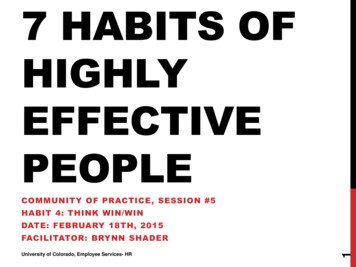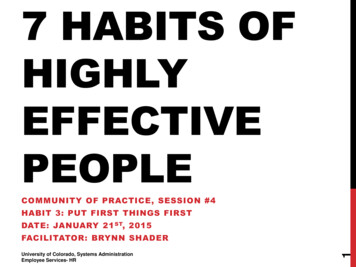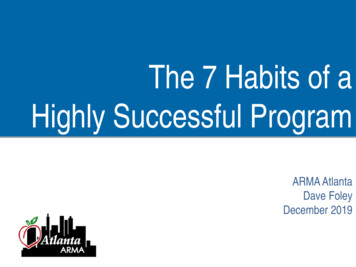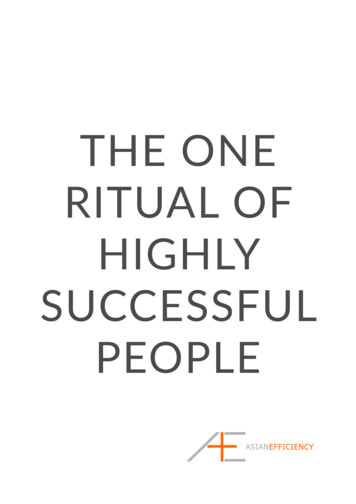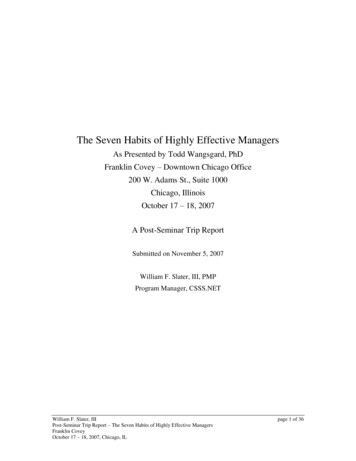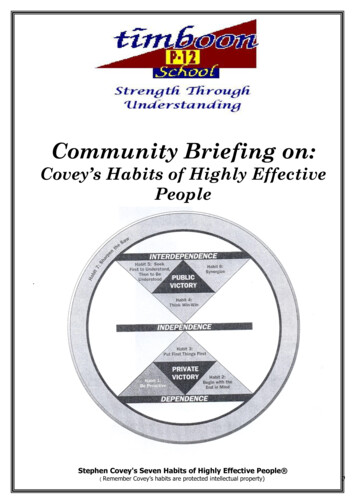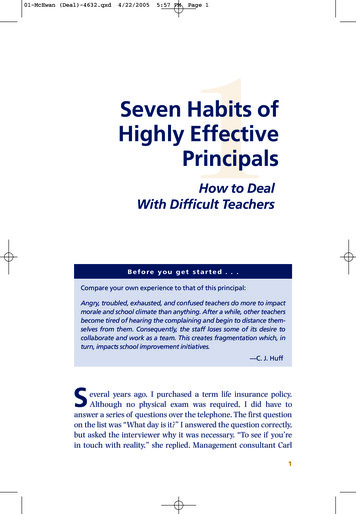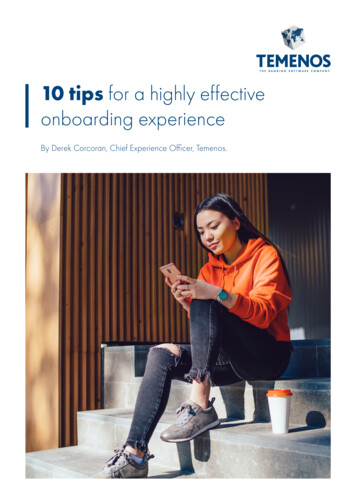
Transcription
10 tips for a highly effectiveonboarding experienceBy Derek Corcoran, Chief Experience Officer, Temenos.
IntroductionWhen we consider the customer journey in banking – we can divide it in to 3 main stages.MarketingAssuming the customer is in themarket for a banking product,Marketing will ensure the bank is“found” and positioned as havinga relevant product or serviceoffering for the customer.SalesThis is the process wherebythe customer will Apply for aparticular product or service.This involves providing detailslike name, contact information,financial information etc andmay require the uploading ofdocumentation to verify thosedetails. During this process,the bank will perform the usualidentity, fraud, credit and riskchecks to ensure they can dobusiness with the customer.MarketingIs the bank being“found” wherecustomers are“looking” for financialsolutions? Are thesolutions aligned tocustomer needs?ServiceOnce the customer has beenonboarded, the bank will “lookafter them” through serviceofferings like mobile/onlinebanking, branches, call center,relationship managers, financialadvisors etc.SalesIs the onboardingprocess easy andconvenient forcustomers?ServiceOnce the customerhas been onboarded,is the ongoing serviceexperience what theyexpected so they say?3
For the purposes of this paper, we’re going to focus on the Sales (also called onboarding, origination, acquisition,etc.). Working in this space for many years, Temenos has identified a number of “Best Practices” to ensure that theSales part of the journey is effective.IN THIS DOCUMENT WE’VE SELECTED 10 OF THEMOST IMPORTANT PRACTICES THAT WE ENCOURAGECLIENTS TO FOLLOW WHEN DESIGNING THEIRBANKING SALES JOURNEYS AND THEY ARE:ADD TO CART1or 1-Click Checkout2BUY NOW WITH 1-CLICK34Two paths topurchase fortwo differentproductsPut the “Apply”button on yourhome page (or1 level down)Re-iterate thefeatures of theproductNurture leads5678910Steercustomers tothe path ofleast resistanceFocus on designsimplicity,not fancy UXwidgetsCategorizefields andask toughquestions lastLook outsidebanking forinspirationDetails likeheadings,disclosuresand fonts canbe importantDesign formobile first,then scale upThe recommendationsare not in any particularorder or importance.So let’s start at the startwith 1.4
1Two paths to purchase fortwo different products.Design your acquisition experiences around 3 basic patterns:Consumerswho want abank;Consumers whowant a productand know whatthey want;Consumerswho want aproduct but arestill shopping /price sensitive.Have you ever used Amazon 1-Click to make a purchase? It’s hard to deny the beauty in the simplicity of the experience. You save yourpreferred delivery address and purchase method and then you can buy things with a single click. In the world of ecommerce in 1999,this was such a revolutionary design that Amazon was awarded a patent for One-Click which stood until September 2017. Meaning,Apple paid a royalty to Amazon for every iTunes purchase made by consumers using Apple’s version of One-Click.But with such a revolutionary design, did Amazon do-away with the Shopping Cart? No! Amazon recognized there were different pathsto purchase and offers both Shopping Cart and 1-Click. For example: I want to buy a cover for my new smartphone, 1-Click is perfect. I want to buy presents for the kids for Christmas, but realize I should run this by my wife I put the items in my shopping cart and weagree on what stays before we place the order.Amazon has further emphasized the need for different paths to purchase with the launch of Amazon Go stores and the purchase of theWholefoods Supermarket chain in the US. When you’re hungry at lunchtime, even the speedy 2 hour Amazon Now! delivery times won’tsatisfy an empty stomach quick enough. In the world of ecommerce, there’s still a place for traditional stores and even the world’s largestonline retailer recognizes that.But what’s that got to do with banking? Every bank would like to think that customers don’t just want “a product”, they want a financialpartner. And in some cases, this is true – and these are extremely valuable customers. But for many (if not most) customers, their primaryneed is typically a product. And that product need is driven by a life event.First jobNeed a deposit accountFirst childNeed a savings accountGot a bonus at workNeed a term deposit / CDCar broke downNeed a loanTerrible flat mateNeed a mortgageAnd in some cases, the customer has already done their research on a product comparison website, and they know what they want. Inother cases (especially for loans / mortgages) the customer may still be shopping – trying to determine if they can afford the car loan ormortgage.5
However, there are still scenarios where the customer does want a bank as a whole, not a single product. Perhaps they’ve moved house.Or they want to break-up with their current bank due to poor service or bad PR recently.So when looking at customer acquisition, we encourage you to design around three different use cases to create compelling purchaseexperiences that align to how consumers want to buy.ScenarioI want a product, and Iknow what I wantI want a product, but I’m I want a whole-of-bankstill shoppingrelationshipProductBank accountCredit CardCar LoanMortgage The individual has done theirhomework (comparisonwebsite, your website, socialmedia peers etc.); The individual knows they wanta loan, but they’re not sure ifthey can afford it yet;Behaviour They’ve selected the productthey want (best interest rate,lowest fees, best rewards etc.); They want to get a sense ofwhat the monthly repaymentswill be before committing; They click Apply.Everything The individual has selected yourbank on the basis of research(branch locations, comparisonsites, social media etc.); They don’t just want a product,they want a conversation thatthey know will lead to products. They click Apply.Design Immediately ask for Name,Email and Phone as this personis genuinely interested. Use this data to create a leadbefore asking for more Contact,ID or Financial information If they don’t complete theapplication NURTURE them.They want this product, make iteasy and demonstrate that youwant their business! Ask for the minimum information Determine if they want toto provide an indicativeself-serve digitally OR talk tocost (e.g. Monthly Car Loansomeone (in-person, by phoneRepayments);or video chat); Allow them to play withthe numbers to adjust thecalculation; Once they move to the nextstep, get Name, Email andPhone – you’ve got themexcited about what this productcould help them achieve. Nowcapitalize on that interest. Get to know the customersdemographics (Age, FamilySituation, Work Situation,Goals, etc.); Make productrecommendations that makesense for them; Then take them through theproduct applications – butonly ever ask for a piece ofinformation once. Even if thereare multiple applications tocomplete.I know this can appear that you’re building varied acquisition experiences – but this is not where you want to save money by buildingsomething that’s easy for you to maintain. You’ve invested a lot in marketing to get the customer to this point make the next step perfect.Whether that’s 1-Click, a shopping cart or a store make it perfect.6
2Put the Apply button on your homepage (or one level down)The majority of people visiting aw bank website are doing so for one of two reasons:To log in to online bankingTo get a new productDon’t make it hard to find the Apply Now button for your most popular products.As this chart below shows, 25% of visitors to a new bank website are “Prospective Customers” (source: Extractable, The Financial Brand).And in the world of comparison websites like bankrate.com and comparethemarket.com – a lot of those prospective customers arecoming to the bank’s website ready to apply for a specific product.WEBSITE VISITORS SEGMENTSREASON FOR CUSTOMER VISITS5%10%5%25%Breakdown ofvisits to financialinstitutions’websitesOtherProspective Customers85%70%Current CustomersOtherPublic MarketingOnline BankingSource: Extractable March 2016 The Financial Brand25%of visitors to a new bank website are“Prospective Customers”7
And in many cases, the bank is running a particular campaign ata time (Low Rate Mortgage, Rewards Credit Card, High InterestSavings Account etc.). So many of the prospective customers willbe enquiring about or wanting to apply for that currently promotedproduct.And sophisticated banks with digital marketing capabilities willrecognize repeat visitors or visitors that have seen a digital ad(through cookies) and change the banner ad to reference whatthey feel confident the customer will be interested in.But, so often the Apply button will be buried several levels downon the website.Home PageProduct Type (e.g. Lending)Home LoansFixed Rate LoansAPPLY NOWSmarter banks realize that they should put the Apply Now button on the Home Page or at most 1 level down – making it easy for peopleto find the product they want to apply for and begin the process.Here are some examples from a range of institutions:And this aligns with the strategy of the best “sales” company in the world – Amazon.When you’re looking at an item on amazon.com, the “Add to cart” and ”Buy Now” buttons are clearly visible. And when you go to yourShopping Cart, there’s a “Place your order” button at the top and bottom of the screen and as you scroll through a long shopping cart, thebutton follows you down the screen. YOU NEVER HAVE TO LOOK FOR IT! Amazon have made shopping easy. Do the same for your bank.8
3Re-iterate the featuresof the productAt the beginning of the applicationexperience (immediately after the customerhas clicked Apply), re-iterate the key featuresof the product in question OR the offerthey’re responding to. This will ensure theyfeel confident they’re applying for the rightproduct and motivate them to commenceand complete.There’s a reason Amazon and other ecommerce companies show images of products when you go to check-out with physical goods,being able to see them reinforces the impulse to buy (plus, they want to make sure you’ve put the right thing in the shopping cart).Well the same is true of banking products. We don’t have a shopping cart, but we do have an Apply process. And very often, the Applyprocess is identical for similar products – product groups like Checking/Current Accounts, Savings Accounts, Credit Cards may all haveidentical application processes within that product group. But I may be applying for a particular account or card and it’s important that Iknow I’m completing the right application.And the value of reminding the customer that they’re applying for the right product holds true just like it does in ecommerce.Imagine a scenario whereby you’ve spent 10 minutes comparingSavings Accounts on a bank website and you’ve selected the onewith the following key features: No minimum balance No monthly account keeping charges 1.5% interest rateYou click Apply Now and you see this screen Is that the right Savings Account? Sure it’s “a” savings account butis it the one I researched with those features I’m interested in?By simply re-iterating those key features, we can reassure theapplicant they’re in the right place.9
Even worse, imagine you’ve targeted a new customer with a great offer through digital marketing. As is common in the US at the time ofwriting this piece, banks are offering cash bonuses from 200 to 500 just for customers to open a checking account and meet someminimum deposit requirements. So customers are seeing adds like this:A nice targeted ad in Facebook with a compellingoffer but when they click Apply Now, they seean application for a bank account alright, but noreference to the 500 that motivated them to click!Are you in the right place?Is this the right product?Are you going to get 500?Don’t assume customers knows it’s the rightapplication form remind them why they clickedApply Now. Pass in context from your marketingand let them know they’re on their way to thatproduct they just selected.How much more compelling would that experiencebe if it looked more like this A subtle but powerful change.10
4NurtureleadsWhen someone abandons an application for a banking product, it doesn’t alwaysmean they’re not interested. Life can get in the way. So generate and nurture leads fromincomplete applications.About 5 years ago we were working with a large bank to improvecompletion rates on Personal Loan applications. The bank put inplace a nurturing process for the first time – meaning, abandonedapplications (incomplete applications) would be followed-up. Thisbank chose to call customers that abandoned their Personal Loanapplication.40%They convertedof the people they called to customers.Yes, 40%.We talked with the bank about the process and the head ofdigital explained that in addition to offering the customer helpto complete their application (explaining that the bank hadn’tthrown away their data) they also asked “why” the customer hadabandoned. They heard stories like “my laptop crashed” or “myphone lost connection” and even “my child threw-up so I had togo deal with that and when I got back to my laptop, the sessionhad timed out”.Hearing this we concludedlife gets in the way”Applying for a banking product takes time usually too long, butwe’ll talk about that another time. So while people are completingan application, life can get in the way. The phone rings, they losepower or connectivity, they get distracted. But that doesn’t meanthey’re not interested in the product they started applying for. It justmeans they got distracted because “life gets in the way”.People who provide you with Name, Email and Phone Numberare genuinely interested in a product – they should be nurtured tosee if you can help them complete the application.Plus – contacting someone to let them know “you want theirbusiness” will demonstrate that you value their business and wantto establish a financial relationship
10.10.2020 · Marketing will ensure the bank is “found” and positioned as having a relevant product or service offering for the customer. Sales This is the process whereby the customer will Apply for a particular product or service. This involves providing details like name, contact information, financial information etc and may require the uploading of

